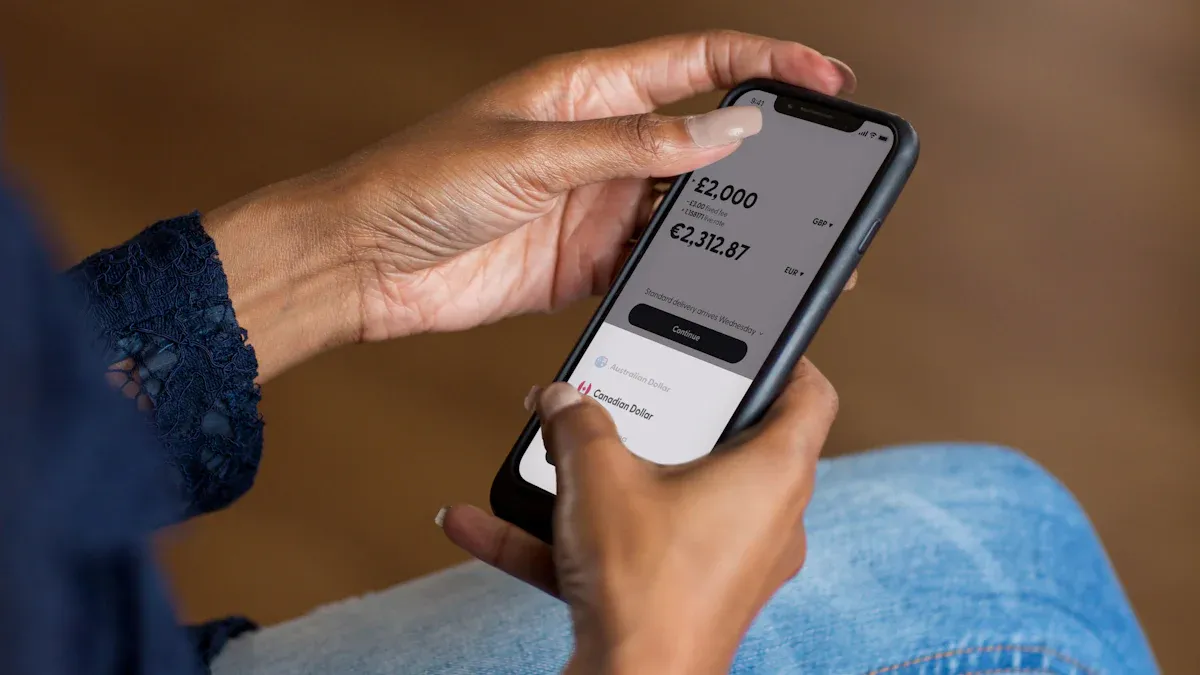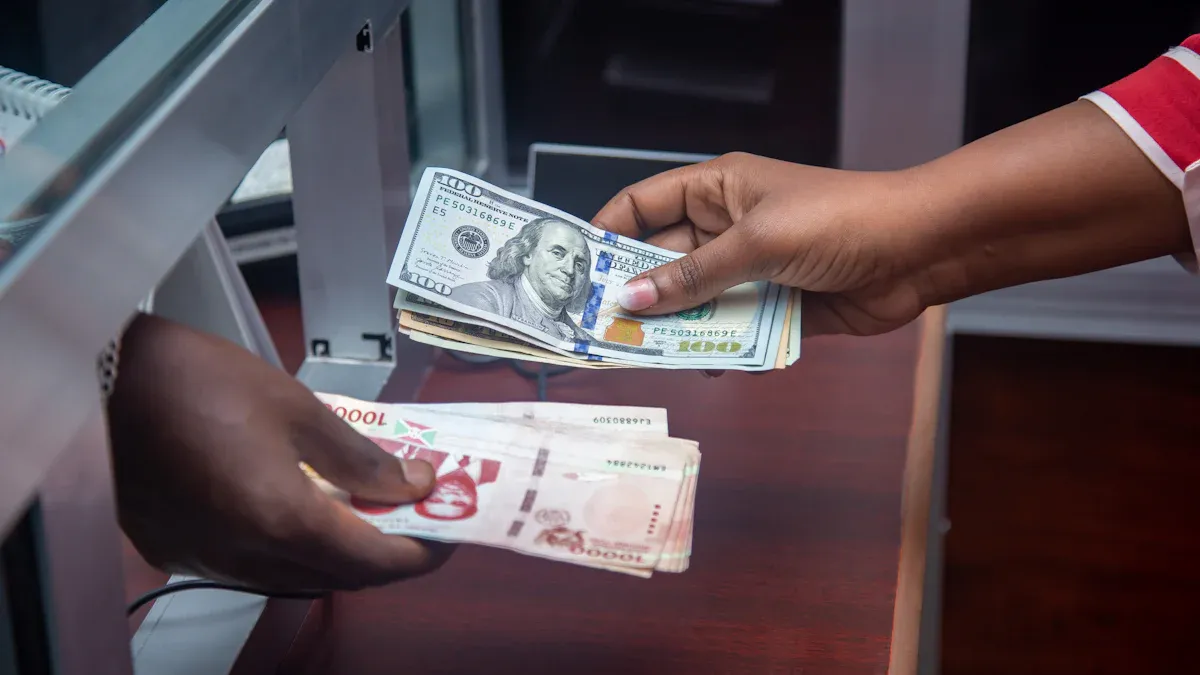- EasyCard
- Trade
- Help
- Announcement
- Academy
- SWIFT Code
- Iban Number
- Referral
- Customer Service
- Blog
- Creator
Still Paying High Fees? Learn About Stablecoin International Remittances

Image Source: unsplash
Are you still troubled by high international remittance fees and long waiting times? According to statistics, the average cost of traditional remittance methods is close to 7%, and a remittance often takes 1 to 5 business days to arrive.
Now, you can experience a completely new way. Stablecoin international remittance is like sending a “currency email,” arriving almost instantly with extremely low costs.
This article will guide you hand-by-hand through a simple three-step method to keep total fees under 1%, easily achieving free global fund flow.
Key Points
- Stablecoin international remittances have low fees and fast arrival, more efficient than traditional bank transfers.
- Choosing TRC20 network to transfer USDT can significantly reduce remittance fees.
- When buying and selling USDT on P2P platforms, compare exchange rates and operate in batches to reduce risks and costs.
- Carefully verify the recipient address and network before remittance to avoid fund loss.
- Stablecoin remittance operations are simple, but ensure account security and enable two-factor authentication.
Why Choose Stablecoin International Remittances?
You might wonder why traditional remittances are both expensive and slow. There are several reasons behind this. Your funds need to pass through multiple banks, each with its own processing time and fees. Add in holidays and time zone differences across countries, and the entire process becomes lengthy and complex.
Traditional Remittance vs. Stablecoin: Cost and Efficiency Comparison
Now, let’s look at the disruptive advantages of stablecoin international remittances with a clear table. It’s like the “currency email” we mentioned earlier, completely changing the game.
| Feature | Traditional Remittance (Bank Wire) | Stablecoin Remittance (USDT) |
|---|---|---|
| Fees | 5%-10% of total or $20-$50 per transaction | Usually under 1% |
| Arrival Time | 1-5 business days | Within minutes |
| Service Hours | Limited by bank hours | 7x24 hours, year-round |
| Intermediaries | Involves multiple banks | Peer-to-peer, no intermediaries |
With stablecoin international remittances, you no longer need to wait for banks to open. Whether day or night, you can complete transfers in minutes at extremely low costs.
What is a Stablecoin (USDT)?
You might worry about cryptocurrency price volatility. Stablecoins were designed to solve this issue. The most mainstream is USDT (Tether).
USDT is designed to maintain a 1:1 value peg with the USD. This means 1 USDT is worth approximately 1 USD.
To achieve this, issuer Tether claims that for every USDT issued, equivalent real assets (mainly USD) are held in reserves. This mechanism ensures USDT’s value remains relatively stable, so you don’t worry about losses from sharp price swings during remittances. Think of it as “digital USD” on the blockchain.
Step 1: How to Buy USDT at Low Premium?

Image Source: unsplash
With the mindset ready, we now enter the practical phase. To keep total costs under 1%, the first step is to buy USDT at a price as close as possible to the real-time exchange rate. The key lies in choosing the right trading platform and timing.
Choose Mainstream C2C/P2P Trading Platforms
To buy USDT with fiat currency (e.g., USD, HKD), the most mainstream and flexible way is through C2C/P2P trading platforms.
C2C stands for Customer-to-Customer, also known as P2P (Peer-to-Peer). In this model, the platform acts as an “escrow”. You trade directly with other users; the platform temporarily holds the seller’s USDT until you pay and the seller confirms, then releases it to your account. This ensures transaction security.
Many platforms offer C2C/P2P services. To help you choose, we’ve compiled some globally popular platforms and their features:
| Platform Name | Main Features | Supported Payment Methods | Security Measures |
|---|---|---|---|
| Binance P2P | Largest global volume, many merchants, rich choices | Over 700 payment methods, covering most regions | Escrow service, user rating system, 24/7 support |
| OKX P2P | User-friendly interface, good liquidity, wide trading pairs | Multiple local payment methods | Escrow service, mandatory KYC, risk control system |
| Bybit P2P | Fast execution, zero fees on some pairs | Various local currencies and methods | Escrow service, strict merchant audits |
| KuCoin P2P | Over 30 fiat currencies, beginner-friendly | Over 100 payment methods | Escrow service, mandatory KYC, feedback/rating system |
| Paxful | Extremely flexible payments, over 350 methods | Bank transfers, e-wallets, gift cards | Strong escrow, user reputation ratings |
How to Determine if a Platform is Safe and Reliable?
When choosing a platform, price isn’t the only criterion; security is always first. Evaluate reliability with these points:
- Account Security Measures: Does the platform mandate two-factor authentication (2FA)? This is the basic defense against account theft.
- Fund Storage Strategy: Does the platform publicly store most user funds in “cold wallets” (offline)? This greatly reduces asset loss risk from hacks.
- Regulation and Transparency: Is the platform registered in a strictly regulated region? Does it regularly publish Proof of Reserves to prove solvency?
- User Feedback and History: Check other users’ reviews. Any unresolved major security incidents? Smooth withdrawals?
- Customer Support: Can you quickly reach support when issues arise? Responsive support shows responsibility.
A reliable platform proactively implements these measures, not shifting all responsibility to users.
Seize Exchange Rate Timing to Reduce Costs
When buying USDT on C2C/P2P platforms, prices are usually slightly higher than the real-time USD rate; this difference is the “premium.” It’s your main cost when buying USDT. For example, if the real-time rate is 1 USD = 7.8 HKD, but the platform quotes 1 USDT = 7.85 HKD, the extra 0.05 HKD is the premium.
This premium isn’t fixed; it fluctuates in real-time due to various factors:
Market supply and demand is the decisive factor. When USDT demand is high in a region, merchants raise quotes, increasing premium. Conversely, when sellers outnumber buyers, premium drops; you might even buy below real-time rate.
Additionally, global economic events (like interest rate changes) and overall crypto market trends indirectly affect USDT demand, altering short-term prices.
To buy at lower cost, use these strategies:
- Compare Different Merchants: Within the same platform, merchant quotes vary. Spend a few minutes browsing to choose the best quote with good reputation.
- Observe Rates at Different Times: Trading activity varies throughout the day. Try checking prices at different times (morning, afternoon, late night) to find lower premium windows.
- Small Test Transactions: If first time on a platform or with a merchant, test with a small amount (e.g., $100) to ensure smooth process.
By choosing a safe platform and patiently finding the best timing, you successfully complete the first step of low-cost remittance.
Step 2: How to Achieve Lowest Cost Transfer?
You’ve successfully bought USDT at low premium. Now, we enter the second key cost control phase: transfer. If buying USDT is “exchanging money,” this step is the actual “remittance.” Choosing the right transfer “highway” can reduce fees from tens of dollars to under $1.
Prefer TRC20 Network: Achieve Lowest Transfer Fees
USDT exists on multiple blockchain networks, like cash flowing in different banking systems. The most common are ERC20 (Ethereum-based) and TRC20 (TRON-based).
Your choice directly determines transfer cost and speed.
Think of ERC20 as a busy downtown road: heavy traffic, frequent congestion, so “toll” (network fee) is very expensive. Think of TRC20 as a new eight-lane highway: smooth and unobstructed, so “toll” is extremely cheap.
Let’s feel this difference with data.
| Network Name | Typical Fee Range | Why Choose It? |
|---|---|---|
| TRC20 (Recommended) | $1 - $2 | Extremely low cost, fast speed, ideal for small and large remittances. |
| ERC20 | $10 - $50+ | High fees, heavily affected by congestion, not suitable for low-cost remittances. |
Why are TRC20 network fees so low? It’s due to its underlying design. TRON was built for high throughput and low-cost transactions. It handles about 2000 transactions per second (TPS), far exceeding Ethereum’s 15-30 TPS. Less congestion and efficient architecture naturally bring lower fees.
Therefore, for stablecoin international remittances, TRC20 is your top choice for lowest cost transfers.
Withdrawal Operation Guide: Correctly Select Network
Understood the theory, now let’s look at specific operations. Transferring USDT from your platform account to the recipient’s address is usually called “withdrawal.”
Though interfaces vary slightly, core steps are consistent.
- Enter Assets or Wallet Page: Log into your platform account, find “Assets,” “Wallet,” or “Funds” section.
- Select USDT and Click “Withdraw”: Find USDT in your assets list, choose “Withdraw.”
- Fill Withdrawal Information (Most Critical Step):
- Address: Obtain and paste the recipient’s USDT receiving address.
- Network: This is the most error-prone and critical step. You must select TRC20 here. In apps like Biyapay, the withdrawal interface clearly lets you choose the network to avoid mistakes.
- Amount: Enter the USDT quantity to transfer.
- Confirm and Complete Security Verification: The platform will prompt you to double-check address, network, and amount. After verification, enter your password, email code, or Google Authenticator (2FA) code to authorize.
Important Tip: How to Confirm Address and Network Match? Before transfer, confirm with the recipient that the address supports TRC20. A simple visual check: TRC20 addresses usually start with uppercase “T”. If you paste an address starting with “0x,” it’s likely ERC20; do not select TRC20.
Common Mistakes to Avoid Asset Loss
Blockchain transfers differ from traditional banking: once confirmed, transactions cannot be reversed or changed. This means operational errors can lead to permanent fund loss.
Here are several common mistakes to watch for during transfer; check each to ensure no issues.
-
Mistake 1: Wrong Network Selection This is the most common and fatal error. Sending USDT via TRC20 to an ERC20-only address means funds vanish forever into the blockchain “black hole”. Platforms cannot recover; recipients never receive.
Prevention: Before transfer, repeatedly confirm the network supported by the address. Ensure selected network matches address type.
-
Mistake 2: Copy-Paste Address Error Wallet addresses are long, random strings. Manual input is error-prone; copy-paste also risks issues.
Prevention:
- Verify Head and Tail Characters: After pasting, carefully check the first 5 and last 5 characters match the original exactly.
- Beware Clipboard Hijacking: Some viruses monitor your clipboard. When copying an address, it replaces it with a hacker’s upon paste. Always verify head/tail to detect this.
-
Mistake 3: Trusting Strangers or False Information Scammers use various tactics to trick you into sending USDT to them.
Prevention:
- Beware “Address Spoofing”: Scammers create addresses very similar to your usual ones. Always get the latest address from trusted sources; don’t rely on history.
- Don’t Scan Unknown QR Codes: QR codes are addresses. Never scan payment QR codes from unofficial groups, DMs, or emails.
- Fake Support: Anyone claiming to be platform support and asking for passwords, codes, or transfers to a “safe account” is a scammer.
By strictly following the above guidelines and security rules, you can safely and low-cost complete the transfer, sending funds across oceans in minutes.
Step 3: How to Efficiently Exchange for Fiat?

Image Source: pexels
Your USDT has safely and quickly arrived in the recipient’s wallet. Now, we reach the final step: efficiently exchanging these digital dollars back to local fiat currency, usually called “cash-out.” The goal is to sell USDT at the best rate to minimize final cost loss.
Compare Cash-Out Rates on Recipient Platforms
To convert USDT back to fiat, choose two mainstream paths: P2P trading platforms and instant exchange platforms.
- P2P Trading Platforms: Like when buying USDT, sell directly to individual buyers on Binance P2P, OKX P2P, etc.
- Instant Exchange Platforms: Some platforms or apps allow direct USDT-to-fiat conversion and bank withdrawal, automating the process.
Both have pros and cons; choose based on needs.
| Platform Type | Advantages | Disadvantages |
|---|---|---|
| P2P Trading Platforms | Usually better rates, many choices | Speed depends on buyers, risks of scams or frozen bank accounts |
| Instant Exchange Platforms | Simple operation, fast, low risk | Rates usually worse than P2P, possible hidden spreads |
Cash-Out Core Cost: Exchange Rate Spread No matter how low advertised fees, focus on the final exchange rate. For example, real-time rate is 1 USDT = 7.8 HKD, but the platform sell price is 7.75 HKD; the 0.05 HKD difference is your actual cost, called “spread.” In a $1000 transaction, this equals over $6 loss.
Thus, before selling, open multiple platforms like comparison shopping to see which offers the closest rate to real-time.
Strategy: Small and Batch Selling
When exchanging a large amount (e.g., over $1000), don’t sell all at once. Use a “small, batch” strategy for key benefits:
- Reduce Risk: In P2P, selling large amounts to one buyer risks account freeze if their funds are problematic. Split into small amounts ($200-$500) to different buyers to greatly disperse risk.
- Lock Better Rates: Market rates fluctuate in real-time. Batching lets you capture better prices at different times, raising average sell price.
- Improve Success Rate: Small orders have better liquidity on P2P; more buyers can accept, matching and completing faster.
By carefully comparing platform rates and batch selling, you steadily complete this “last mile,” truly enjoying stablecoin remittance’s low cost and high efficiency.
Case Calculation: USDT Remittance Cost Breakdown
Theory is complete; now let’s feel the cost advantage of stablecoin international remittance with a real case. Assume you remit $1000 from China to the U.S.; we break down the process step-by-step.
Complete $1000 Remittance Process Breakdown
We divide the process into three core steps and calculate possible fees per step.
- Buy USDT (Deposit): Buy USDT with fiat on P2P. Usually slight purchase premium. Assume 0.5% premium; cost is:
$1000 * 0.5% = $5 - Transfer USDT (Withdrawal): Use lowest-cost TRC20 to send from your platform wallet to recipient’s address. Network fee (Gas Fee) is fixed, about:
1 USDT ≈ $1 - Sell USDT (Cash-Out): Recipient sells USDT for USD on U.S. P2P. Possible exchange loss. Though some platforms charge up to 1.99% fixed fee, optimal P2P trading keeps loss around 0.5%. Cost:
$1000 * 0.5% = $5
Total Cost Calculation: Total fees = purchase premium + network fee + sell loss = $5 + $1 + $5 = $11
Final Cost Comparison and Savings Checklist
Now compare this with traditional methods.
| Remittance Method | Estimated Total Fee ($1000) | Savings |
|---|---|---|
| USDT Remittance | About $11 | - |
| Traditional Bank Wire | $20 - $50 | Saves 45% - 78% |
To ensure optimal cost every time, check this savings checklist before remittance:
- ✅ Check Internal Transfer: Ask if recipient uses the same platform. Internal transfers are usually free and instant.
- ✅ Prefer Lowest Cost Network: If not internal, confirm TRC20 with recipient.
- ✅ Verify Address and Network: Before transfer, carefully check address head/tail characters and ensure network matches address type.
- ✅ Reserve Enough Fuel Fee: Ensure wallet has enough native tokens (like TRX) for network fees to avoid failure.
- ✅ Watch Platform Promotions: Some platforms or wallets offer fee-free withdrawal events; seize these.
Now, you’ve mastered the core three-step stablecoin international remittance method: buy low on preferred platforms, transfer via TRC20, and sell optimally in batches.
This method not only saves money; it represents a financial efficiency revolution. Stablecoins enable 24/7, near-instant global fund flow, completely free from traditional bank constraints.
While embracing this new tool, always prioritize security. Enable two-factor authentication (2FA) for your accounts and use strong, unique passwords to keep digital assets safe.
FAQ
Is stablecoin remittance legal?
Laws vary by country and region. You must understand and comply with local digital asset regulations. It’s compliant where allowed, but restricted in some areas.
Will USDT’s price drop?
USDT is 1:1 pegged to USD, backed by reserve assets, so its value is relatively stable. Market supply/demand causes minor fluctuations, but unlike Bitcoin, it doesn’t swing wildly, making it ideal for value transfer.
Are there other hidden costs besides fees?
Your total cost consists of three main parts, not entirely hidden:
- Purchase Premium: Difference from real-time rate when buying USDT.
- Network Fee: Fixed fee for blockchain transfer, about $1 on TRC20.
- Sell Spread: Exchange loss when selling USDT for fiat.
Is the entire process complex for beginners?
Not complex. If familiar with online banking or e-wallets, you can easily master it. The core flow is “buy-transfer-sell.” Just follow this guide’s steps and carefully verify each.
*This article is provided for general information purposes and does not constitute legal, tax or other professional advice from BiyaPay or its subsidiaries and its affiliates, and it is not intended as a substitute for obtaining advice from a financial advisor or any other professional.
We make no representations, warranties or warranties, express or implied, as to the accuracy, completeness or timeliness of the contents of this publication.




Contact Us
Company and Team
BiyaPay Products
Customer Services
is a broker-dealer registered with the U.S. Securities and Exchange Commission (SEC) (No.: 802-127417), member of the Financial Industry Regulatory Authority (FINRA) (CRD: 325027), member of the Securities Investor Protection Corporation (SIPC), and regulated by FINRA and SEC.
registered with the US Financial Crimes Enforcement Network (FinCEN), as a Money Services Business (MSB), registration number: 31000218637349, and regulated by FinCEN.
registered as Financial Service Provider (FSP number: FSP1007221) in New Zealand, and is a member of the Financial Dispute Resolution Scheme, a New Zealand independent dispute resolution service provider.




















